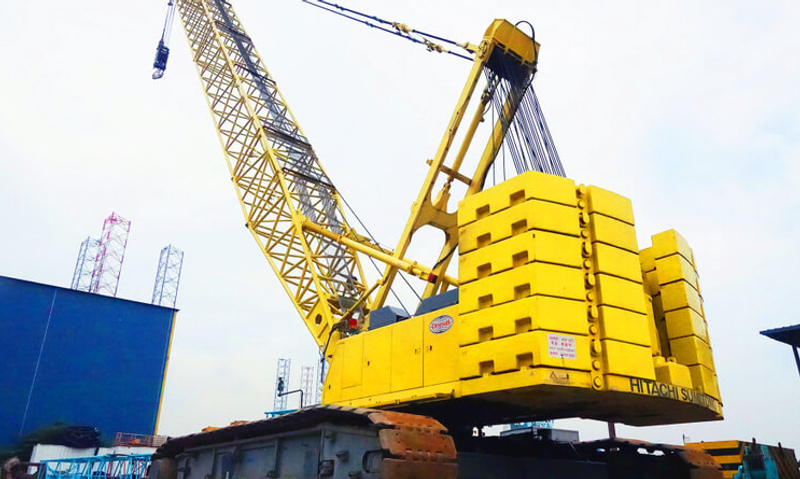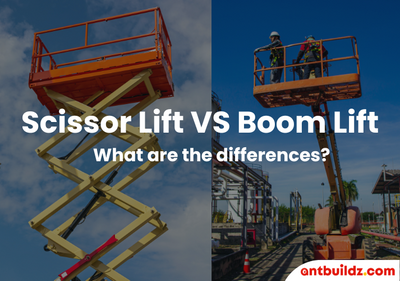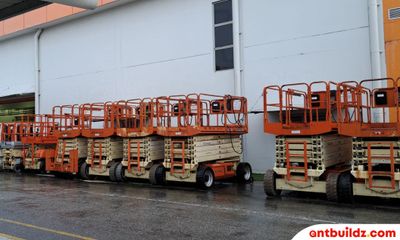© 2025 Powered by Antbuildz.com
© 2025 Powered by Antbuildz.com

When it comes to lifting tasks, it is crucial to rent an appropriate crane that can effectively handle the job at hand. Specifically, for lifting work, you have three options to consider: crawler cranes, mobile cranes, or rough terrain cranes. Instead of solely relying on guidance from a crane rental company, you can ensure making the correct choice by following a few straightforward assessment steps. By following these steps, you'll be able to determine the most suitable crane for your specific lifting requirements.
Learn Other Important Construction Equipment here.
If the ground is firm and stable, any of the options - crawler, mobile, or rough terrain crane - would be suitable for use. However, in situations where the ground is muddy and uneven, it is advisable to consider a crawler or rough terrain crane as they offer better maneuverability and stability. Additionally, the ground bearing pressure plays a crucial role in ensuring the crane's outriggers or crawler tracks can withstand the load. In such cases, the use of outrigger mats and crane mats is often necessary to distribute the weight and protect the ground surface.
It's important to assess the site space and determine whether it's an open area or constrained by structures. If the site has limited space or is constrained by structures, a crawler crane may not be the most suitable option due to its large body dimensions. In such cases, mobile cranes and rough terrain cranes are more favorable as they offer greater maneuverability and can navigate through narrow access points with relative ease. However, if the site space is open and unrestricted by structures, all crane types can be considered for use. It's essential to take into account the specific site conditions to make an informed decision about the most suitable crane for the job.

Mobile cranes have the advantage of being self-driven and can easily maneuver into the site. They offer flexibility in terms of positioning and are well-suited for various job sites. The space required for a mobile crane can be determined by considering the outrigger deployment. The provided drawing above illustrates the total space required once the outriggers are deployed. This drawing helps in assessing and planning the necessary area to ensure safe and efficient crane operation. By considering the outrigger extension, you can ensure that the site has adequate space to accommodate the mobile crane during its operations.

Crawler cranes are different from mobile or rough terrain cranes because they need to be put together piece by piece before they can be used. This assembly process requires a larger area compared to the other types of cranes. To understand how much space is needed for a crawler crane, you can refer to the next drawing, which will show you a visual representation of the area required for assembling the crane. Considering the assembly area is important to make sure there is enough room on the site to put the crawler crane together properly.
Another factor to consider is whether you require the crane for a single lifting task or a series of lifting tasks that could extend for more than a day or month. If it's a one-time lifting job, it may be more practical to eliminate the option of a crawler crane. This is because setting up a crawler crane is a complex and time-consuming process. Unlike other types of cranes, a crawler crane is transported to the site in separate parts and needs to be assembled on-site. Additionally, it's worth noting that crawler crane rentals are often offered on a monthly basis, which may not be cost-effective for a single lifting project.

In this case, you only have the option of rough terrain and a mobile crane.
Next, it's important to consider the size and weight of the cargo you need to lift. If the cargo is large and requires a lifting frame or beam, you should check the length of the crane's boom to ensure there is enough space between the cargo and the boom during lifting. Crawler cranes generally have longer booms compared to other cranes, which can be helpful for maintaining a safe distance. However, if the cargo doesn't have any size-related concerns, all three types of cranes can be considered.
Additionally, you should check the weight of the cargo. If the cargo is very heavy, rough terrain cranes may not be the best choice, as they are not designed to handle extremely heavy loads. The maximum capacity of a rough terrain crane is typically around 150 tons. On the other hand, mobile cranes can handle loads up to 1000 tons, and crawler cranes can lift even heavier loads. Considering the weight of the cargo will help you determine which type of crane can safely and efficiently handle your specific lifting needs.
Once you've identified the suitable crane type based on the cargo size and weight, it's important to refer to the crane's lifting chart. The lifting chart provides specific information on lifting capacities at different heights and radii for each brand, model, and type of crane. For crawler cranes, different boom and counterweight configurations can result in different lifting charts. Consulting the lifting chart ensures that you select a crane that can safely lift your load. By considering the height, radius, and specific lifting capacities, you can make informed decisions for safe and efficient crane operations.

When checking the lifting chart, it's important to consider the different types of boom configurations and counterweights. Ensure that you refer to the correct lifting chart by matching the outrigger, counterweight, and boom configuration specifications. Once you have the right chart, simply match the lifting radius (X-axis) and boom length (Y-axis) to determine if the chosen crane can safely lift your cargo. By following this process, you can quickly assess whether the selected crane is capable of handling your specific lifting requirements.

Lastly, consider the total cost when making your decision. Lifting operations involve various factors and complexities. Moreover, different rental companies may offer their own range of cranes. It's crucial not to rely on just one rental company, as they may suggest a higher capacity crane simply because they have it available. Instead, take the time to study and determine your basic crane requirements. Shop around and gather quotes from multiple rental companies. Having a good understanding of cranes can help you negotiate and obtain the best value for your needs. By being knowledgeable and comparing options, you can make an informed decision that balances both suitability and cost-effectiveness.
We are the first intelligent digital platform in Singapore set to reinvent the traditional construction equipment rental into a touchless equipment rental experience. Rent your excavator or other equipment that you need here with just a few clicks.
Remember to like and share our Facebook page!bit.ly/34MdSFh
Any Questions?
WhatsApp or Call Us for a FREE consultation on the most suitable equipment for your site. We’re more than happy to assist!
Related Articles

What are the Differences between Scissor Lift and Boom Lift?
When working at heights, safety is paramount. But beyond safety gear and proper ...
Learn more
22 Jan , 2025

6 Most Common Uses For Buggy Rental
When it comes to traversing to several locations within your site, The Buggy is ...
Learn more
22 Jan , 2025

The Future Landscape of Scissor Lift Rental in South East Asia
Scissor lifts, integral to various industries such as construction, facilities m ...
Learn more
22 Jan , 2025

Top 5 Common Construction Safety Issues & Mitigation Plans in Construction Industry
Construction sites are dangerous places. Some of the dangers, such as heavy cons ...
Learn more
22 Jan , 2025